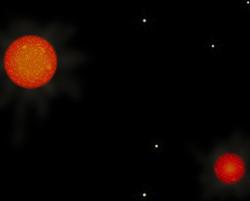Astronomers have identified 20 new suns in our galactic environment in a six-year survey conducted at an observatory in the Andes Mountains in Chile.

Astronomers have identified 20 new suns in our galactic neighborhood, including the 23rd and 24th nearest stars to the Sun. When added to the eight solar systems discovered by the same team and six more discovered by other groups since 2000, the known population of stars within a radius of 33 light years from Earth (10 persec) has increased by 16 percent in the past six years.
The discovery was made by a group calling itself the Research Consortium on Nearby Stars (RECONS), which has been using small telescopes at the US National Science Foundation's Inter-American Crew Tulolo Observatory in the Andes of Chile since 1999. These new results will appear in the December issue of the Astronomical Journal. Journal.
"Our goal is to help complete the census of our local neighborhood and provide statistical insights into the demographics of the stars in our galaxy – their masses, their evolutionary state and the frequency of multi-star systems," says project director Todd Henry of Georgia State University in Atlanta. "Due to their proximity, these systems are excellent targets for the study of planets outside the solar system, and finally, also for astrobiological studies that will try to determine whether one of their planets has conditions suitable for life.
The twenty new objects are all of the red dwarf type, making up 239 of the 348 objects closest to our solar system to within 10 persec. Indeed, stars of this type seem to make up 69 percent of all the inhabitants of the Milky Way.
"Red dwarfs are among the most hollow objects but also the most common for milk" explains Henry. "Although not one of these can be seen with the naked eye, swarms of them are scattered throughout the galaxy." said.
The distance of these stars was measured using the classic trigonometry technology using a 0.9 meter diameter telescope at the observatory in Chile. The parallax technique for measuring stellar distances takes advantage of the simple geometry of the Earth's position changing relative to the universe as it orbits the Sun each year. The back-and-forth motion of nearby stars throughout the year mirrors the Earth's motion around the Sun, just as the finger appears to bend back and forth when you alternately cover each eye.
From Earth, it also appears that nearby stars conduct small eclipses in the sky because Earth does not jump from one side of its orbit to the other but rather glides slowly around the Sun. The extreme points of the earth in its orbit, are for that matter just like the journey between eye to eye inside the head, and the size of the visible movement of the hand depends on the proximity of the hand to the eyes. When it is close, the movement appears larger relative to the background self.
Through observations lasting several years, parallax measurements can be made with an accuracy of a millisecond of arc (0.0000003 degrees), or about two millionth of the width of the full moon. This allowed astronomers to measure distances with an accuracy of plus or minus ten percent for a distance of over 300 light years.
"We are expected to announce additional suns with a radius of 10 persec, said Henry. The pool of nearby stars for which the parallax has not been measured is still inexhaustible." Henry concluded.

6 תגובות
Hello. I ask to name a new star that will be discovered or discovered, by the name "Anita". This is a woman I love tremendously, madly. There are not many loves in the world like my love for her. I really want to commemorate her name in a star. Thank you if you answer my request.
Hello, I again ask that you discover a new star named Anita. I would be happy if you contact me by email and let me tell you the story about Anita. I would ask that you keep the number personally and do not publish it so that there will be no problems.
I would very much like you to contact me by email
And discuss with me the matter I asked to read
to the star "Anita".
I would like to suggest that when they discover a new star they will name it
"Anita". I would really like to call the star that.
The probability of finding life, beyond our planet, is increasing.
eye work
Red dwarfs exist only in the imagination